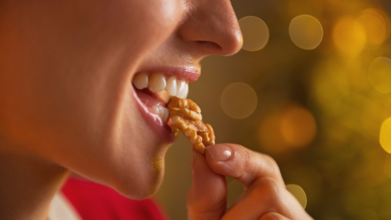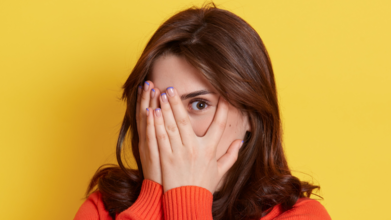- Health Conditions A-Z
- Health & Wellness
- Nutrition
- Fitness
- Health News
- Ayurveda
- Videos
- Medicine A-Z
- Parenting
- Web Stories
Eating These Everyday Nuts Could Help You Lower Your Risk Of Colon Cancer

(Credit-Canva)
We have all heard our elders talk about the benefits of nuts and seeds, they constantly tell us to snack on these instead of unhealthy foods. These popular nuts are not only desert friendly but something that research shows to have anti-cancer properties: Walnuts.
A new clinical study from the UConn School of Medicine has found that eating walnuts can help reduce the risk of colon cancer. The research, published in the journal Cancer Prevention Research, shows that a special substance in walnuts helps fight inflammation in the body.
Why Walnuts Are So Effective Against Cancer
Walnuts have natural plant chemicals called ellagitannins. When you eat walnuts, the bacteria in your gut change these chemicals into very powerful molecules called urolithins. These urolithins are what make walnuts so good at fighting inflammation and possibly cancer.
In the study, researchers found that patients who had high levels of a specific urolithin (called urolithin A) had less inflammation in their bodies. They measured this by checking blood, urine, and even stool samples. The benefits were especially noticeable in patients who were obese, as their bodies were able to create more of this helpful urolithin.
How the Study Worked
The study included 39 patients, all between 40 and 65 years old, who were already at a higher risk for colon cancer. The trial had two main parts:
The Starting Phase: For one week, the patients had to stop eating any foods or drinks that contained ellagitannins to make sure their urolithin levels were as low as possible.
The Walnut Diet: For the next three weeks, the patients ate walnuts as part of a carefully watched diet.
At the end of the study, doctors performed a detailed colonoscopy on everyone. They looked closely at any small growths, called polyps, that were removed. Using advanced technology, they could see what was happening at a cellular level inside these polyps. They made some key discoveries:
- Patients with high urolithin A levels had lower levels of certain proteins that are often found in polyps.
- They also saw a big drop in a protein called vimentin, which is often linked to more serious forms of colon cancer.
These findings are a major step forward because they are the first to show that eating walnuts can directly improve colon health in people.
The main researcher, Dr. Rosenberg, says that eating walnuts can significantly increase urolithin levels in people with the right gut bacteria. This can help lower inflammation and might even help prevent cancer. He suggests that simply eating a handful of walnuts every day is an easy and effective step you can take for your long-term health.
Key Health Benefits of Walnuts
The official dietary guidelines recommend eating about 5 ounces of nuts, seeds, and soy products each week. One serving of walnuts, which is about one ounce, contains:
Heart Health
Walnuts are the only common nut that contains a significant amount of alpha-linolenic acid (ALA), a type of omega-3 fatty acid. This compound helps reduce inflammation, which can lower your risk of heart disease.
Brain Health
The antioxidants and anti-inflammatory compounds in walnuts may help your brain function better and slow down mental decline that can come with age. This includes improving your memory and ability to think clearly.
Gut Health
Your gut is home to trillions of bacteria and microbes that are essential for your health. Studies have shown that eating walnuts daily can lead to a healthier mix of bacteria in your gut.
Can’t Stand Watching People Fidget? What Is 'Misokinesia'—The Hidden Condition That Makes Small Movements Unbearable

Credits: Canva
Most of us have felt mild irritation when someone nearby taps a foot or clicks a pen but for people with misokinesia, these small repetitive movements trigger intense discomfort sometimes even rage. The reaction isn’t just in the mind. Physical symptoms can include a spike in blood pressure, adrenaline surges, heart palpitations, or nausea. Mentally, sufferers may experience anxiety, anger, disgust, or difficulty concentrating.
The condition can be selective certain people’s movements may be more triggering than others making it harder to maintain relationships or work comfortably in shared spaces.
What Is Misokinesia?
The term translates literally to “hatred of movement.” While its auditory counterpart, misophonia, has gained some public awareness in recent years, misokinesia has remained largely unexplored until recently. In contrast to misophonia, in which sound is the primary irritant, misokinesia is motivated by visual stimuli—nail biting, hair twirling, or restless leg shaking, for example.
A 2021 University of British Columbia (UBC) study discovered that nearly one in three individuals reported some degree of sensitivity to these movements. The study, conducted by psychologist Sumeet Jaswal, was the first scientific study of the phenomenon, which drew on the input of over 4,100 participants.
Is Misokinesia Common?
Researchers were surprised by the prevalence. Misokinesia is not restricted to people with diagnosed mental health conditions—it appears to be a common social challenge affecting a significant portion of the general population.
UBC psychologist Todd Handy began researching the phenomenon after his partner revealed that his own fidgeting caused her stress—just as anyone else’s fidgeting did. This personal experience sparked a formal investigation into what might be happening in the brain.
While modern environments may not directly cause misokinesia, today’s constant visual stimulation—open-plan offices, crowded public spaces, and high screen time might make symptoms harder to ignore.
Why do some people have such a strong reaction to fidgeting while others barely notice?
Researchers explored whether misokinesia could be tied to heightened visual-attentional sensitivity—an inability to block out peripheral movement. Early results didn’t confirm this theory.
One leading hypothesis involves mirror neurons, brain cells that activate both when we perform an action and when we see someone else perform it. If someone fidgets because they’re anxious, a person with misokinesia may subconsciously “mirror” that anxiety in their own body, creating a cascade of stress responses.
A follow-up 2024 study by Jaswal suggested another angle: people with misokinesia may struggle more to disengage from a visual stimulus than to initially block it out.
Living With Misokinesia
The impact can be substantial. Many report avoiding certain social situations or sitting away from others in classrooms, meetings, or public transport. Workplace productivity can drop when a colleague’s nervous tic is constantly within view.
Some sufferers experience ongoing tension in personal relationships. For example, spending time with someone who “stims”—repetitive self-soothing movements often seen in neurodivergent individuals—can create a conflict of needs that’s difficult to resolve without understanding and compromise.
Misokinesia vs. Misophonia
While the two conditions often overlap, misokinesia is rooted in sight, misophonia in sound. A person might have one without the other, both, or varying degrees of sensitivity to each. Both conditions share emotional triggers—frustration, anxiety, irritability—and both can limit social participation if unmanaged.
How To Deal With Misokinesia Triggers?
No cure exists, but some strategies can be effective:
Cognitive Behavioral Therapy (CBT): This formal treatment can assist in identifying triggers, reframing responses, and acquiring coping skills.
Relaxation measures: Breathing techniques, mindfulness, or grounding exercises can dampen the physiological "fight or flight" response.
Environmental modifications: Occluding the line of sight to the movement, redirecting focus to another visual target, or establishing personal space in seating.
Communication: Educating friends, family, or co-workers about triggers can reduce unintentional exposure.
These methods will not completely prevent the reaction from happening, but they will make symptoms more tolerable and less disruptive.
We remain in the initial stages of understanding misokinesia. That it occurs in so many and is so far from mainstream conversation implies a lack of awareness and clinical recognition. There are many possible areas for further research that may reveal neurological or genetic mechanisms, shed light on the function of mirror neurons, and seek out eventual overlap with sensory processing disorders.
The goal is that by naming and researching the phenomenon, we can transition from quiet frustration to real solutions—less stigma and enhanced quality of life for those impacted.
If you catch yourself distracted by the sound of a pen click or foot tap next to you, you might not be merely "easily irritated." Misokinesia is a known and surprisingly prevalent affliction. Learning about it—whether you have it or know somebody who does—is the first step in making spaces more livable for all.
As Handy succinctly stated, "To those suffering from misokinesia, you are not alone. Your struggle is real and it's common."
Does Your Sunscreen Need A Reality Check—On SPF, Skin Cancer And Tanning Myths

Credits: Canva
Scroll through TikTok, Instagram, or YouTube and you’ll find an unsettling pattern: influencers dismissing sunscreen as unnecessary—or even harmful. Some promote “slow tanning” to build skin’s melanin. Others share DIY sunscreen recipes made from oils and butters. A few outright claim sunscreen causes skin cancer.
This narrative taps into a broader skepticism toward conventional health advice. But dermatologists say it’s a dangerous trend that risks reversing decades of public health progress.
Celebrity voices have amplified these claims. Former TOWIE star Sam Faiers told her 2.5 million Instagram followers she avoids sunscreen for her children, citing fears of “toxic ingredients.” TV personality Kelsey Parker has suggested SPF causes skin cancer. Influencer Lauryn Goodman advises followers to “train your skin” by gradually increasing sun exposure.
To many followers, this advice feels empowering. To dermatologists, it’s reckless.
“The idea that SPF is toxic or that children can ‘build immunity’ to the sun is not only irresponsible—it’s dangerous,” says Dr. Angela Tewari, consultant dermatologist at King’s College Hospital in London. “These views are unscientific and put children’s health at serious risk.”
What Science Actually Shows About Sunscreen Safety?
Concerns about sunscreen ingredients often stem from lab studies—like those showing that high doses of certain chemicals affect rats in the womb. But context matters. To match the chemical exposure levels in those studies, a human would need to apply sunscreen daily for decades—up to 277 years in some calculations.
More recent research, such as a 2019 JAMA study, confirmed that some sunscreen chemicals enter the bloodstream. However, the amounts studied were far higher than typical daily use, and no harm to humans was found.
No credible human studies have shown that sunscreen ingredients like oxybenzone cause cancer. On the contrary, evidence overwhelmingly supports sunscreen’s role in reducing skin cancer risk.
Why Is Skin Cancer Risk Is Real And Rising?
Melanoma, the deadliest form of skin cancer, is climbing worldwide. In the UK, diagnoses are projected to hit a record 21,300 in 2025—up 22% from 2023. In the US, the American Cancer Society estimates more than 100,000 new melanoma cases in 2025.
About 90% of skin cancer cases are linked to unprotected sun exposure. Childhood sunburns are especially dangerous—just one blistering burn can nearly double lifetime melanoma risk. That’s why dermatologists recommend SPF 50 for children during high UV months, from March to September in northern climates, and year-round in sunnier regions.
How Sunscreen Works?
There are two main types:
- Chemical sunscreen absorbs UV radiation and turns it into harmless heat. Ingredients include avobenzone, oxybenzone, and octocrylene.
- Mineral sunscreen (also called physical sunscreen) contains zinc oxide or titanium dioxide to physically block and reflect UV rays.
- Both protect against UVB rays (which cause burns) and, in broad-spectrum formulas, UVA rays (which cause premature aging and contribute to cancer).
SPF, or sun protection factor, tells you how much longer you can stay in the sun without burning compared to no protection. SPF 30, for instance, lets you stay 30 times longer without burning—assuming correct application and reapplication every two hours.
Higher SPFs provide more margin for error. A 2018 study found SPF 100+ sunscreen was significantly more effective than SPF 50+ in preventing sunburn during real-world use.
What is The Myth of ‘Slow Tanning’?
Proponents of slow tanning argue that gradually building sun exposure helps the skin produce melanin, offering natural protection. While melanin does absorb some UV rays, it’s no substitute for sunscreen. Even deeply pigmented skin can burn and sustain DNA damage, which accumulates over time.
According to dermatologists, “training” the skin is a myth. UV damage occurs from the very first unprotected exposure—whether or not you burn.
Why Are Some People Abandoning Sunscreen?
Distrust in health authorities, desire for “natural” living, and negative personal experiences with certain products all contribute. Some people have had allergic reactions or irritation from sunscreen ingredients, leading them to avoid it altogether.
That’s why dermatologists stress that not all sunscreens are the same. Mineral sunscreens are generally better tolerated by sensitive skin. Newer formulations avoid oxybenzone and other controversial ingredients, while still providing strong UV protection.
The American Academy of Dermatology and the World Health Organization both recommend daily use of broad-spectrum sunscreen with SPF 30 or higher. They emphasize that sunscreen is one of the most effective tools to prevent skin cancer—especially when combined with shade and protective clothing.
How to Protect Yourself And Be 'Safe'?
- Choose broad-spectrum SPF 30 or higher.
- Apply liberally—most adults need about a shot glass–sized amount for full body coverage.
- Reapply every two hours, or after swimming or sweating.
- Use mineral formulas if you have sensitive skin or want to avoid certain chemicals.
- Pair sunscreen with shade and UPF-rated clothing for best results.
The anti-sunscreen movement thrives on fear and mistrust, but science paints a very different picture. Sunscreen doesn’t cause skin cancer—it helps prevent it. And while research into ingredients continues, the risks of skipping SPF are well-established and potentially deadly.
Scientists Link These 6 Sleep Traits To 172 Diseases, Check Your Risk Level

Credits: Canva
We tend to hear we need a "good night's sleep" if we want to be healthy. But there's evidence now that it's not how much you sleep—it's how you sleep. A huge study of more than 88,000 individuals has identified six specific sleep characteristics with the risk of developing 172 separate diseases, and this indicates that poor sleep rhythms can be much more harmful than we ever imagined.
Investigators at Peking University and the Army Medical University in China examined data from the UK Biobank, tracking participants for a median of 6.8 years. They didn’t just track how long people slept—they examined six core sleep traits:
- Sleep length
- Sleep onset (bedtime)
- Sleep rhythm (regularity of sleep-wake cycles)
- Extent of sleep
- Sleep efficiency
- Frequency of night wake-ups
Their findings, published in Health Data Science, show that sleep rhythm—how consistently you go to bed and wake up—was the single strongest predictor of health outcomes.
Why Sleep Rhythm Is Important Your Health?
Participants with the most irregular sleep rhythms faced up to a 2.8-times higher risk of Parkinson’s disease and a 1.6-times higher risk of type 2 diabetes compared to those with the most regular patterns.
Sleep rhythm was associated with nearly half of the 172 diseases identified—three times as many disease links as sleep duration or bedtime alone. That list included hypertension, COPD, acute kidney failure, depression, and several metabolic and cardiovascular conditions.
“Time we broaden our definition of good sleep beyond just duration,” says Shengfeng Wang, senior author and epidemiologist at Peking University.
Why Bedtime Is More Crucial Than You Might Expect?
The research also uncovered significant bedtime-related risks. People who routinely went to bed after 12:30 a.m. were 2.6 times more likely to develop liver cirrhosis than those who went to bed before 11:30 p.m.
Meanwhile, low sleep efficiency—time spent actually sleeping versus just lying in bed—was linked to a nearly 1.8-fold increase in respiratory failure risk.
Why Wearable Data Changes the Game?
This study stands out because it used both self-reported surveys and objective wearable sleep monitor data. And that revealed an important truth: we’re not always accurate about our own sleep. Nearly one in four people who claimed to be “long sleepers” actually slept fewer than six hours a night when measured objectively.
This discrepancy matters because previous studies relying solely on self-reported sleep may have underestimated—or overestimated—the role sleep plays in various diseases.
The researchers explain, “Some participants with difficulty falling asleep or keeping stable sleep may have spent a long time in bed but have short real sleep.” That misclassification skews results and may mask the impact of poor sleep patterns.
Traditionally, public health advice has focused on getting seven to nine hours of sleep per night. But this research indicates that sleep quality, timing, and regularity could be as significant—if not more so—than duration alone. For instance:
- Consistent sleep rhythms seem to lower risk across neurological, cardiovascular, and metabolic illness.
- Earlier bedtimes could guard against liver health issues.
- High sleep efficiency could lower respiratory and cognitive decline risk.
Whereas the research can't establish causation—it demonstrates correlations, not cause-and-effect per se—the size of the dataset makes the results difficult to ignore. The researchers also confirmed the findings using a different large database, the U.S. National Health and Nutrition Examination Survey (NHANES), further bolstering the evidence that these sleep characteristics are associated with general health outcomes.
If verified by subsequent research, these results may redefine sleep health policy and contribute to guided interventions for vulnerable populations.
Disease was once recognized as a consequence of poor sleep, but this study puts a different spin on the discussion. It implies that we may need to consider sleep as much as we consider diet—not merely the "amount" (calories or hours), but the "quality" and "consistency" count as much.
As Dr. Wang and collaborators say, the aim should be to "expand our definition of good sleep" to encompass rhythm, timing, and efficiency. At least for the moment, that could entail establishing a regular bedtime, steering clear of late-night screen exposure, and tracking patterns with wearable devices—rather than merely hours slept.
© 2024 Bennett, Coleman & Company Limited

